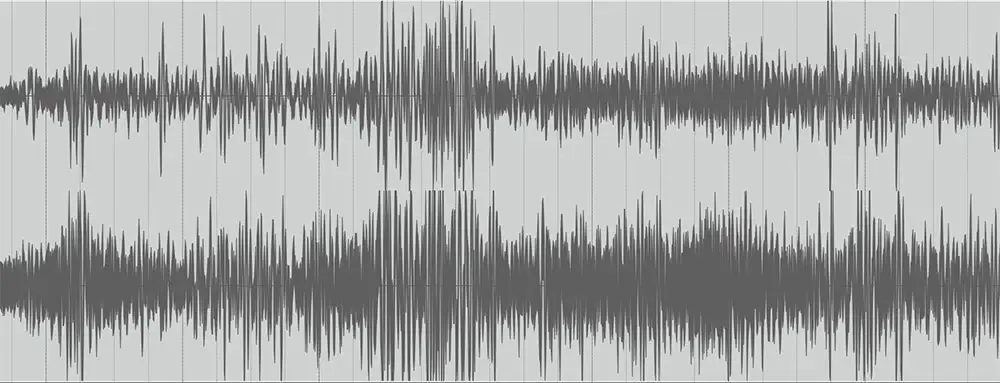Have you been feeling stressed or sleepless?
Do you find that silent meditation doesn't quite cut it for you?
Noise is one of the best forms of healing around. Sounds like pink noise, white noise, and more, can help ease your mind and build a unique sense of wellness.
Of course, many of us watch the rain on the windowpane or ocean waves roll ashore without ever considering the fact that the pink noise coming from them has a major impact on the comforting experience.
By paying attention to sound color, however, it is possible to practice a unique form of mindfulness throughout each day, which can, in turn, promote better sleep, alleviate stress, and ease physical ailments.
Understanding Noise Colors
We often think of noise colors in physics, electronics, or audio engineering. Different noise colors have different properties. The 'sense of color' that you get in noise signals is very similar to musical timbre or tone color. Similar to these audio signals on the sound spectrum, the different frequencies of the noise spectrum sound different to the human ears.
If you dissect a sound wave and break it down to its fundamentals, you get a few characteristics:
- Frequency - The quickness at which the waveform vibrates each second
- Noise Type - A loose analogy for light colors

What Is White Noise?
Put all seven colors of the rainbow together and what do you get?
White light.
Similar to color, if you put every band of the noise spectrum together, you get what we call white noise .
If you look at it through a spectral analyzer, you can see flat spectral density. The beauty of white noise doesn't lie in its physical character, but in what it can do. You can hear white noise in music, especially in percussion.
People will also often use random white noise to help with tinnitus, sleeplessness, or background noise blocking. You've probably heard it before, as it's the sound you get when static appears on the TV.
White Noise Sample:
What Is Pink Noise?
Pink noise has become a phenomenon in recent years. Many people think of it as the medicinal darling of the noise spectrum. Pink noise encompasses a vast array of natural sounds, including leaves rustling, falling rain, and ocean waves.
Many people refer to it as "inverse 1/f noise" or "flicker noise" due to the fact that it has power density that reduces 3 dB per octave.
Compared to white noise, which is often attributed to the hum of air conditioning, whirring fans, or static, people are finding that pink noise is a better choice for concentration and sleep. The sonic pink noise hue is much deeper than white noise as well, reducing the negative impact of jarring sounds that wake one from sleep or meditative states.
Thanks to the fact that pink noise can mask various sounds and unwanted background noise, it's the perfect choice for concentration. Many people who suffer from chronic tinnitus even note that pink noise has proven useful.
Pink Noise Sample:
Colors of the Noise Spectrum
Brown Noise Vs. Pink Noise
Even deeper in the noise frequency spectrum than pink noise lies brown noise , which is made up of low-frequency bass tones. Brown noise decreases by 6dB per octave, giving it a much stronger power density than pink noise.
Some examples of brown noise include low, roaring frequencies, such as thunder or waterfalls.
Contrary to popular belief, brown noise does not get its name from the colors of noise, but from the fact that it comes from the Brownian motion , a signal akin to the "random walk" pattern. Brownian noise was named after Robert Brown, a Scottish botanist, who was the very first scientist to take on the study of Brownian noise fluctuations in the early 19th century.
Many people use red noise as a synonym for brown noise, though the terminology is used quite loosely. Some people use the term "red noise" to refer to a system in which power density decreases as frequencies increase.
Brown Noise Sample:
Blue Noise Vs. Pink Noise
Blue noise otherwise referred to as azure noise, is made up of very few low frequencies and more high frequencies, which makes it quite difficult to discern. We like to think of blue noise as the hiss you get when a watering hose has a kink in it.
At high volumes, blue noise can be fairly harsh. For this reason, it's very rare that therapy machines will use it. The unique thing about blue noise is that its power density increases by 3dB per octave.
The best application for blue noise is dithering , an audio engineering process that smooths out audio while lessening distortion audibility. If you arrange retinal cells in a blue noise pattern, you get good visual resolution.
If you go slightly deeper than blue noise, you get violet noise, otherwise called purple noise. You can think of violet noise as blue's more intense cousin . Violet noise at high volumes can be extremely harsh, as it has tons of energy concentrated in high frequencies.
Blue Noise Sample:
Gray Noise Vs. Pink Noise
Gray noise is a lot like pink noise in that it sounds the same at every frequency . If we look at the grey noise curve, we can see that it represents the A-weighting psychoacoustic equal loudness curve, which is the reason we get equal power from every frequency.
In contrast with the white noise spectrum, grey noise has equal strength over the linear frequency scale.
Gray noise calibrates better with the human ear, though the strange thing is, we don't have a single-best example of gray noise out there. Because every person has a slightly different hearing curve, there are plenty of different examples.
In the medicinal realm, medical professionals will use it to treat tinnitus or hyperacusis, which is increased sensitivity to everyday sounds.
Gray Noise Sample:
Green Noise
Green noise lies in the center of the frequency spectrum and has a limited frequency range that centers around 500 Hz . Ironically enough, green noise supposedly represents ambiance that stems from nature.
Green Noise Sample:
Orange Noise
Orange noise is kind of strange in that many people describe it as the sound of an out-of-tune ensemble. To most ears, this noise is clashing and cacophonous.
Orange Noise Sample:
Black Noise
At the very bottom of the spectrum, far below blue noise, pink noise, and brown noise, lies black noise. Black noise is what we like to refer to as the Simon & Garfunkel frequency, or the sound of silence .
The spectral density of black noise is roughly zero at each frequency.
Where Do These Colors Come From?
While humans can't hear or see noise color, humans hear multiple sound waves infused and superimposed in various frequencies. To clarify, frequencies are vibrations of waveforms that happen every second.
This phenomenon is not the same as synesthesia , wherein people start hearing certain frequencies or sounds when they see certain colors. Noise is composed of infinite single-source frequencies . The unique thing about noise is that it is impossible to measure frequency amplitude, even with the high-end hardware we have available today.
To get a better idea of what these noise types represent, we must divide them into various bands, including:
- 0-1kHz
- 1-5kHz
- 5-10kHz
- 10-15kHz
- 15-20kHz
We can then measure these frequency bands using a spectral analyzer. We then use watt measurement to calculate noise power for each band, giving every color its name.
The Healing Properties Of Noise
While the pink noise spectrum is the most popular in the health realm, scientists around the world use various frequencies to help with insomnia, anxiety, and memory loss.
People will often administer the pink noise pattern at night to evoke deeper sleep, which can, in turn, put our brains into a state of restoration that optimizes our focus and concentration during our waking hours.
Deep sleep is critical for creating and consolidating memories. Scientists believe that our lack of restorative sleep as we age is a major contributor to memory loss.
Overall, the use of noise for health, whether it is to enhance focus, sleep, mood, or motivation, is a promising field that seems to be gaining popularity more and more each day.
Colors of Noise FAQs
Do Colors Have Noise?
Yes. Different colors have different noise properties. Most of those noises that we associate with lie in the white, pink, brown, and blue spectrum. Each color can be used for a wide variety of purposes, especially in the medicinal world.
What Color Noise Is Best For Anxiety?
White noise can be one of the best colors to help with anxiety, especially if you have trouble sleeping at night. The steady drone of white noise is wonderful for insomnia. You may also want to try pink noise for the same ailments.
Is It Okay To Play White Noise All Night?
Yes. It is okay to play white noise throughout the night. However, you should not play it throughout the day. While white noise can be relaxing, it's good to take a break from it to allow your system to reset.
What Color Noise Is Best for Concentration?
When it comes to concentration, focus, and productivity, it is best to stick with either pink or white noise. Ambient noise like this can range from the ambient sound of a local coffee shop to the sound of water gently flowing downstream.
What Age Should you Stop White Noise?
If you have any concerns about overusing white noise and creating dependency for your child, we recommend waiting until they are around three years old to start slowly weaning them off. We recommend slowly turning the sound down slightly every night until you stop playing it altogether.
Is Rain White Noise?
While the sound of steady rainfall can resemble the sound of white noise in many ways, not all rain sounds are on the white noise spectrum. This is because the environment in which there is rainfall can impact the noise colors.
Is Pink Noise Safe?
Yes. Pink noise is safe for people of any age who want to use it for sleep, anxiety reduction, or concentration. However, if you are very sensitive to sound, you might find that it can be a bit frustrating or jarring.
Is A Fan White or Pink Noise?
While many associate the whir of a fan with white noise, the sounds usually have nothing to do with true white noise at all. In fact, the sound of a fan is actually a mix of pink, brown, green, or blue noise.
What Is The Most Relaxing Sound To Fall Asleep To?
Many people say that white and pink noise are some of the best noises to fall asleep to. However, many people also swear by ASMR, ocean sounds, rain sounds, oscillating fans, and calming music. It's up to you to test things out for yourself, as every human ear is different.
What Is Meant by 1/f Noise?
1/f noise is a unique low-frequency noise in which the power of noise is inversely proportional to the frequency. People can observe 1/f noise in music, biology, and economics, though scientists first discovered it through electronics.
Why Is Everything Louder At Night?
The fact that everything seems louder at night has to do with a psychoacoustic effect. Because there are fewer ambient noises or background noises at night, even the softest sounds sound louder. Plus, sound often travels faster and better in colder temperatures.
Is Sleeping With Sound Bad?
Sleeping with sound can have a positive impact on those with insomnia, though you must approach it with caution. If you sleep with the wrong kind of noise regularly, you could negatively impact your health, making your insomnia worse.






